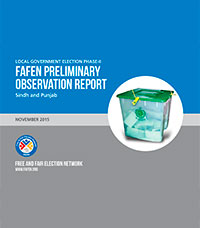Voters in twenty-six districts of Punjab and Sindh provinces went to the polls to elect their local government representatives in an election characterized by illegalities and irregularities amidst weak enforcement and monitoring by the Election Commission of Pakistan (ECP) or its designated officials, says FAFEN Preliminary Observation Report on Local Government Election Punjab and Sindh Phase II.
The party-based election, however, witnessed an impressive turnout and remained largely peaceful despite fears of violence in some districts of Sindh and Punjab.
The last minute cancellation of election in 81 local councils of eight districts by ECP in pursuance of the orders of the Sindh High Court (SHC) had already dampened the election environment in Sindh, with one major political party in the province dubbing the decision as ‘controversial’. The ECP had to postpone the elections on the eve of polling day over “irregular delimitation” of these areas after Supreme Court abstained from granting a stay against the orders of SHC, observing that Election Commission is a constitutional institution having powers to make its own decisions.
The second phase of the Local Government election was originally scheduled to be held in 27 districts on November 19, 2015 but the ECP had to postpone the exercise in Sanghar due to heightened political temperatures which had rung security alarm bells. Similar situation was also brewing in Badin, but ECP gave a go ahead to polling in the district where infighting between PPP factions had been showing signs of turning violent on the Election Day. Keeping in view the security environment during the first phase of election which was held on October 31, 2015 and particularly the killing of 11 people in Khairpur at a polling station, the ECP sought the assistance of Pakistan Rangers and Army to provide Election Day security. The decision worked well as the Election Day largely remained peaceful with only sporadic incidents of brawls, scuffles and frays among political workers reported from polling stations in various districts.
To download the complete report, click here


